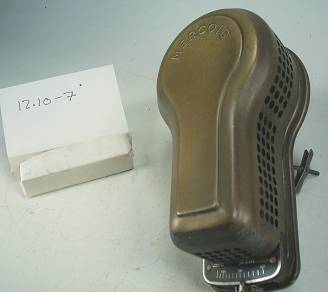Pressure Atomizing Oil Burner Equipment and Systems – Room Temperature Thermostats
An early, automatic room temperature control device, in large, decorated brass enclosure, using an hydraulic bellows, temperature sensor, with large mercury bulb, line voltage switching, and calibrated scale 60 to 80 degrees F. Temperature control devices of this genre, would introduce automation into the Canadian house hold and become markers of profound social and cultural change; Type 0104111, Mercoid Corp., Circa 1927. [See also ID # 213]
Features:
– built in line voltage connection junction box
– original box connector for shielded cable, used in the period
– original 3 inch toggle bolt used for mounting on lath and plaster walls of the period
Technical Significance:
* The competing, thermostat, technologies of the day were helical bimetal spring temperature and hydraulic bellows designs. The copper bellows with heavy spring ballast appears to be less responsive for household home applications, possibly better suited to commercial situations in which Mercoid had made its name.
* Equipped with a finely calibrated scale, locking adjustment lever, and leveling adjustment screws, it uses a large, commercial type, 3″ mercury tube switch.
* Much larger and much less finely sculptured than its Time-O-Stat counterpart, and without the sales appeal, it appears to be targeted on a different market segment.
* Requiring a robust contact structure, capable of handling line voltage motor starting current, would make this device much less responsive to room temperature changes than later, low inertia devices with heat anticipation features, see for example #ID 217 and 220
Industrial Significance:
* Mercoid’s concept of what a room thermostat should look like, in order to please the tastes of the well-to-do marketplace appears well behind those of their competitor, Time-O-Stat [See ID # 215].
* Considerably less elegant in appearance, this thermostat mirrors Mercoid’s experience in commercial and industrial controls of the period. It could well be the company’s initial foray into the residential, room thermostat market, where it would find that appearance was everything.


